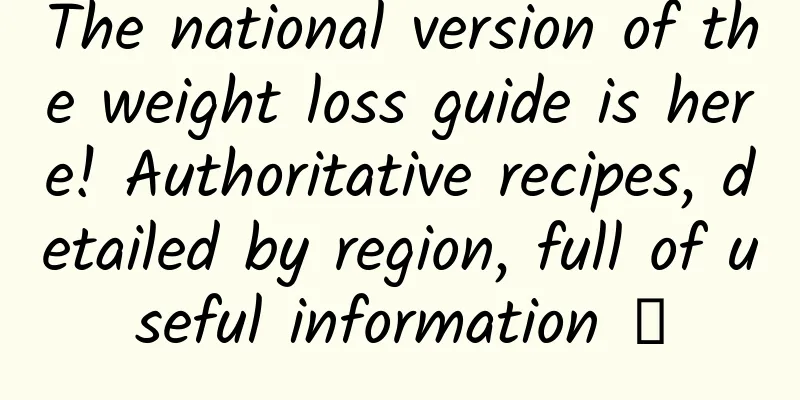The national version of the weight loss guide is here! Authoritative recipes, detailed by region, full of useful information →

|
"Abnormal weight can easily lead to high blood pressure, diabetes, cardiovascular and cerebrovascular diseases, fatty liver, and even some cancers are related to abnormal weight." "Some people have large waistlines, are overweight, and even suffer from chronic diseases... This requires the help of professional doctors and professional medical institutions." On March 9, the Third Session of the 14th National People's Congress held a press conference. Lei Haichao, director of the National Health Commission, said that the weight management year action will continue to be promoted to popularize a healthy lifestyle. The "Weight Management Guidelines (2024 Edition)" released to the public by the National Health Commission pointed out that some studies predict that if not effectively curbed, the overweight and obesity rate among adults in China will reach 70.5% in 2030, and the overweight and obesity rate among children will reach 31.8%. What kind of fat is really overweight and obese? Overweight and obesity are influenced by many factors, including genetics, diet, physical activity level, lifestyle habits, and changes in social environment. Body mass index (BMI) is a standard for measuring how fat or thin a person is. BMI = weight (kg) / height (m)² The normal BMI range for healthy adults in China is between 18.5 and 24 . A BMI between 24 and 28 is defined as overweight . · Obesity is defined as a BMI of 28 or more . Among these, BMI is further divided into mild obesity, moderate obesity, severe obesity, and extremely severe obesity. How to eat healthily to lose weight? Previously, the National Health Commission released the "Dietary Guidelines for Adult Obesity (2024 Edition) " , which teaches you how to lose weight scientifically!
For example, the spring recipes in the Northeast region include "fish stewed in an iron pot" and "rice wrapped in vegetables", while the recipes in the Northwest region include "臊子面" and "油爆面". 📢These foods are preferred Encourage people to eat whole grains as the main staple food , increase coarse grains appropriately and reduce the intake of refined white rice and flour; Ensure adequate intake of fresh fruits and vegetables, but reduce the intake of high-sugar fruits and high-starch vegetables; Give priority to low-fat ingredients, such as lean meat, skinless chicken breast, fish and shrimp; · Prefer low-fat or skimmed milk. 📢Eat less of these foods During the weight loss period , you should eat less high-energy foods such as fried foods, sugary baked goods, candies, fatty meats, etc. (High-energy foods usually refer to foods that provide more than 400kcal/100g of energy). During the weight loss period , the diet should be light, with a daily salt intake of no more than 5g, cooking oil of no more than 20-25g, and the intake of added sugars preferably controlled below 25g. Alcohol consumption should be strictly limited during weight loss. Each gram of alcohol can produce about 7kcal of energy, which is much higher than the energy value produced by the same mass of carbohydrates and proteins. 📢How much should I eat every day? Controlling total energy intake and maintaining a reasonable diet are the keys to weight management. To control total energy intake, we can recommend an average reduction of 30% to 50% or 500 to 1000 kcal in daily energy intake based on the daily energy requirements of different groups of people (as shown in the table below), or recommend a balanced energy-limited diet with a daily energy intake of 1200 to 1500 kcal for men and 1000 to 1200 kcal for women. According to the actual energy requirements of different individual basal metabolic rates and physical activities, overweight and obese individuals can be given 85% and 80% of the intake standards respectively to achieve negative energy balance. At the same time, it can meet the basic demand of energy intake higher than the basal metabolic rate of the human body, helping to lose weight and reduce body fat. The ideal body weight (kg) can be calculated by subtracting 105 from the height (cm), and then multiplied by the energy coefficient of 15 to 35 kcal/kg (generally 15 kcal/kg for bedridden people, 20 to 25 kcal/kg for people with light physical activity, 30 kcal/kg for people with moderate physical activity, and 35 kcal/kg for people with heavy physical activity) to calculate the daily energy intake for an individual adult. Scientific weight loss, these 4 things to remember The "Dietary Guidelines for Adult Obesity (2024 Edition)" recommends that the energy supply ratio of the three major macronutrients should be: fat 20%~30%, protein 15%~20%, and carbohydrates 50%~60%. The recommended energy supply ratio for breakfast, lunch, and dinner is 3:4:3. 1 Eat regularly at regular times and in regular amounts It is important to pay attention to breakfast and not skip meals. Dinner should not be eaten too late. It is recommended to have dinner between 17:00 and 19:00. You should not eat any food after dinner, but you can drink water. 2 Eat less snacks and drink less beverages Whether dining at home or out, you should strive to eat in moderation and with scientific combinations, avoid overeating, control your intake of snacks and beverages, and avoid late-night snacks. 3 Eat slowly and chew thoroughly When eating the same food, chewing slowly can help reduce the total food intake, slow down the eating speed, increase satiety and reduce hunger. 4 Change the order of meals Eating in the order of "vegetables - meat - staple food" can help reduce the amount of high-energy food consumed. Copyright images in the gallery. Reprinting and using them may lead to copyright disputes. In addition to eating, there are these tips for losing weight 1 sleep Staying up late, lack of sleep, and irregular work and rest schedules can cause endocrine disorders, abnormal fat metabolism, and lead to "overwork obesity". Obese patients should follow the circadian biological rhythm and ensure about 7 hours of sleep a day. 2 sports Insufficient or lack of physical activity and a sedentary lifestyle are important causes of obesity. The exercise principle for obese patients to lose weight is to mainly perform low- to moderate-intensity aerobic exercise, supplemented by resistance exercise, for 150 to 300 minutes per week. Moderate-intensity aerobic exercise should be performed 5 to 7 days a week, at least once every other day, and resistance exercise should be performed 2 to 3 days a week, once every other day, for 10 to 20 minutes each time. The energy consumed through exercise per week should be 2000 kcal or more. Copyright images in the gallery. Reprinting and using them may lead to copyright disputes. 3 Sit less The time for sitting still and passive screen viewing should be controlled within 2 to 4 hours per day. Those who sit still for a long time or work at a desk should get up and move around for 3 to 5 minutes every hour. 📢Warm reminder📢 Weight loss should be gradual. The ideal weight loss goal should be to reduce 5% to 10% of current body weight within 6 months. A reasonable weight loss rate is to lose 2 to 4 kg per month. Planning and production Source: CCTV News Editor: Yang Yaping Proofread by Xu Lailinlin |
>>: Does exercising more before bed really help you sleep better?
Recommend
Why is WeChat far less profitable than Facebook?
An interesting data is that in the third quarter ...
Shenzhen Weather + Xinghua 400 website optimization SEO diagnostic analysis!
A few days ago, I found a website with less than ...
Even though Yidao has found a buyer, it still has little momentum to grow.
The mysterious buyer of Yidao has finally surfaced...
WeChat users have reached 1.26 billion! QQ continues to fall sharply
Tencent released its third-quarter 2021 financial...
How do you view the issue that games that have not applied for game licenses before October 1 will be removed from the shelves?
Since the State Administration of Press, Publicat...
Taiyang's new course in 2021: Love Maker
Taiyang's new course in 2021: Love Maker Taiy...
6 indicators to teach you how to formulate financial supermarket operation strategies!
In this article, the author proposes five operati...
Private domain traffic customer acquisition strategy for educational institutions!
The 2020 summer advertising war is about to end, ...
What film and television equipment are needed to shoot micro movies? What tools are needed to make a micro film?
What film and television equipment is needed to s...
Since even light cannot escape from a black hole, why can it be "seen"?
Black holes have always been an incredible existe...
How much does it cost to be an agent of the Yantai Specialties Mini Program?
For entrepreneurs, although mini program developm...
How to boost your immunity? Eat like a rainbow!
Written by: Li Caihong, Chief Nutrition Technicia...
Ammonia treatment administrator: Why can this battery save fish lives?
Author: Duan Yuechu Ammonia is a toxic compound t...
When product and operations disagree, who should you listen to?
Looking through the readers' comments, I foun...
Cell phones will disappear in 5 years!
When digital photography technology subverted fil...









